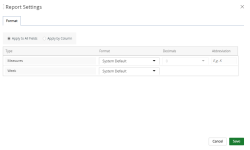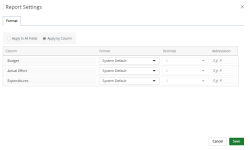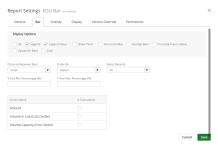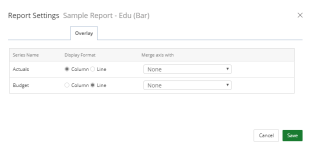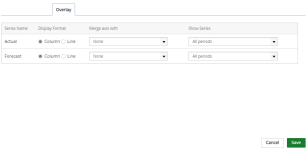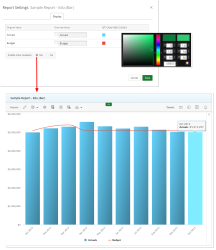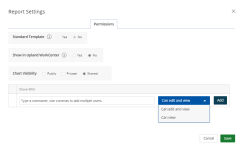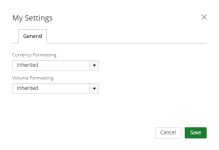Bar settings
You can customize a new or existing bar graph using the available setting options.
-
Open the Main Menu bar and click
 .
. -
Click one of the following:
-
Settings: available only to the Administrator or the graph creator.
-
My Settings: available to users with access rights to review the graph.
-
Settings
Select one or more of the available report settings tabs:
Format tab
Use this tab to apply numeric and week formatting to the graph.
Select one of the following:
- Apply to All Fields: To apply the selected formatting to all numeric and/or week fields in the graph/chart.
- Type: Displays the type of fields that can be formatted:
Measures: Selections made in this row will be applied to numeric fields only.
- Format: Select one of the following formatting option from the drop-down menu:
- System Default: Displays the numeric fields using the default system preferences set by your Administrator.
- Thousands: To format the numeric fields that have values in thousands.
- Millions: To format the numeric fields that have values in millions.
- Decimals: Select the number of digits to display after the decimal for numeric fields that have values in thousands and/or millions. For example, if you select Thousands and then type 3 in this field, the numeric fields that have values in thousands will display as XXX.XXX.
- Abbreviation: Type the abbreviation for the numeric fields that have values in thousands and/or millions. For example, if you select Millions and then type M in this field, the numeric fields that have values in millions will display as XXXM.
- Format: Select one of the following formatting option from the drop-down menu:
- Week: Selections made in this row will be applied to week fields only.
- Format: Select one of the following week formats:
- System Default: Displays the week using the default system preferences set by your Administrator.
- Week of Jan 1 20XX
- Week of Jan 1
- 20XX W01
- Format: Select one of the following week formats:
- Type: Displays the type of fields that can be formatted:
-
Apply By Column: To apply the selected formatting to data fields that contain numeric and week fields.
- Column: Displays the data fields that can be formatted.
- For numeric fields:
- Format: Select one of the following formatting option from the drop-down menu:
- System Default: Displays the numeric fields using the default system preferences set by your Administrator.
- Thousands: To format the numeric fields that have values in thousands.
- Millions: To format the numeric fields that have values in millions.
- Decimals: Select the number of digits to display after the decimal for numeric fields that have values in thousands and/or millions. For example, if you select Thousands and then type 3 in this field, the numeric fields that have values in thousands will display as XXX.XXX.
- Abbreviation: Type the abbreviation for the numeric fields that have values in thousands and/or millions. For example, if you select Millions and then type M in this field, the numeric fields that have values in millions will display as XXXM.
- Format: Select one of the following formatting option from the drop-down menu:
- For week fields:
- Format: Select one of the following week formats:
- System Default: Displays the week using the default system preferences set by your Administrator.
- Week of Jan 1 20XX
- Week of Jan 1
- 20XX W01
- Format: Select one of the following week formats:
Bar tab
Select one or more of the desired Display Options. Depending on your choices the Additional Bar Graph Settings may differ.
- Display Options:
- 3D: Select this checkbox to display the graph in 3D.
- Legend: Select the checkbox to display the legend on the graph. Clear the checkbox to hide the legend. By default, Legend is selected.
- Legend Value: Select the checkbox to display the text and numeric legend values on the graph. Clear the checkbox to hide the legend values. By default, Legend Value is selected.
- Show Total: Select this checkbox to display the grand total within the upper right corner of the graph.
- Horizontal Bar: Select the checkbox to display bars vertically on the graph.
- Overlap Bars: Select the checkbox to overlap the bars on the graph.
- Truncate X-axis Labels: Select the checkbox to cut off the text on the X-axis labels to fit the graph.
- Values On Bars: Select the checkbox to display the total amount at the top of the data bar with a scale to adjust the vertical percentage from 0 - 90 on the graph.
- Grid: Select this checkbox to display the grid layout on the graph. By default, Solid Lines is selected. You can customize your grid layout patterns by selecting any of the available options in the Grid Pattern box.
- Distance between bars: Select how to display the distance between the bars on the graph:
- None
- Small - this is the default
- Medium
- Large
- Y Axis Min Percentage: Type the minimum percentage to zoom into the graph.
- Y Axis Max Percentage: Type the maximum percentage to zoom into the graph.
- Grid Pattern: Select the option to customize the grid layout patterns on the graph. By default, Solid Lines is selected.
- Series Name: Displays the data selected for the Y-axis. Is Cumulative: Select the checkbox for the corresponding series name to display the cumulative amount for that data.
Overlay tab
- Select the data to be displayed as an Overlay in a Bar or Line format and if the axis should be merged.
Actual and forecast values
When your bar chart displays actual and forecast values, the Show Series column displays which allows you to display/hide date periods.
- In the Actual row, select one of the following from the Show Series drop-down list:
- All Periods to display actual values for all periods. This is the default.
- Previous periods to display actual values for only past dates.
- Previous periods + current period to display actual values for only past dates and the actual value for the current date.
- In the Forecast row, select one of the following from the Show Series drop-down list:
- All Periods to display forecast values for all periods. This is the default.
- Future periods + current period to display forecast values for only future dates and the forecast value for the current date.
- Future periods to display forecast values for only future dates.
Display tab
- Original Label Value: Select the checkbox next to the label you want to override and type the new label in the Override Value box.
- Override Colors: Use this checkbox to override the colors on the graph. Select the checkbox and then click on the color and make a new color selection.
- Enable Color Gradient: Select one of the following:
- Yes: To display the colors on the graph in gradient instead of a solid color.
- No: To display the colors on the graph in a solid color.
Version Override tab
Override the versions used for reporting from the default versions.
- Select Yes from the Override Version(s) drop-down menu. A list of default versions display.
- Select the checkbox next to one or more default versions on which you want to report.
- Click Save.
Permissions tab
- Standard Template: Select whether or not to use the standard template.
- Show in Upland WorkCenter: Select whether or not to display the report or graph/chart in Upland WorkCenter.
- Yes: The report is available in Upland WorkCenter.
- No: The report is not available in Upland Workcenter.
- Report/Chart Visibility: Select one of the following:
- Public: Allows your report or graph/chart to be viewed and edited by all users. By default, this option is selected.
- Private: Allows your report or graph/chart to be viewed by you only.
- Share: Allows you to set your report or graph/chart to be viewed by a specific user(s) or role(s) and give permissions. The Shared With field displays:
- Click the Select a value field and select the user(s) or user group(s) for whom you want to share your report or graph/chart with.
- Click the arrow and select the permission for each user or role. The available options are:
- Can edit and view: The default
- Can view
- Click Add.
Note: The roles display as follows: User Group Label (User Group Name).
Note: Click Save at anytime to view your changes.
My Settings
Caution: The options available to you on the My Settings dialog box overwrite those that were set on the Settings dialog box by the Report Owner.
General tab
Select how numbers should be displayed on your graph/chart:
- Select one of the Currency Formatting options:
- Inherited: Selected by default
- With Decimals: 1,000.00
- Without Decimals: 1,000
- Thousands: 100,000.00 or 100,000
- Thousands with decimals: 100.00
- Millions: 1,000,000.00 or 1,000,000
- Millions with decimals: 1.00
- Select one of the Volume Formatting options:
- Inherited: Selected by default
- With Decimals: 1,000.00
- Without Decimals: 1,000
- Thousands: 100,000.00 or 100,000
- Thousands with decimals: 100.00
- Millions: 1,000,000.00 or 1,000,000
- Millions with decimals: 1.00
- Click Save settings to save your changes.
